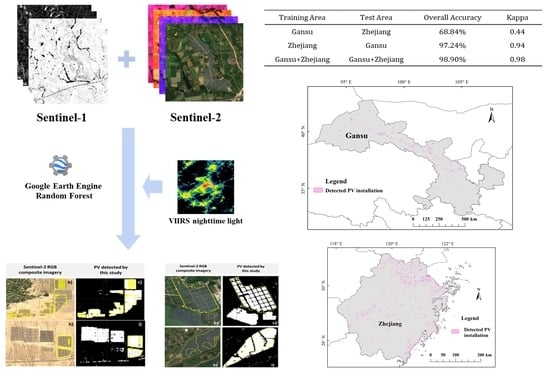Detecting Photovoltaic Installations in Diverse Landscapes Using Open Multi-Source Remote Sensing Data
Abstract
:1. Introduction
2. Materials and Methods
2.1. Study Area
2.2. Satellite Imagery
2.3. Training and Test Samples for PV Detection
2.4. Existing PV Database for Consistency Evaluation
2.5. Method
2.5.1. Preprocessing
2.5.2. Feature Construction
2.5.3. Classification
2.5.4. Accuracy and Consistency Evaluation
3. Results
3.1. Feature Importance
3.2. Comparison among Classification Schemes
3.3. Visual Inspection of Classification Results
3.4. Consistency Evaluation with Existing PV Databases
4. Discussion
4.1. Detection of PV Installations in Diverse Landscapes
4.2. Importance of Multi-Source Remote Sensing
4.3. Accuracy Evaluation of PV Detection
4.4. Limitation and Future Work
5. Conclusions
Supplementary Materials
Author Contributions
Funding
Data Availability Statement
Acknowledgments
Conflicts of Interest
Abbreviations
| FN | false negative |
| FP | false positive |
| GEE | Google Earth Engine |
| GLCM | gray level co-occurrence matrix |
| GPPD | Global Power Plant Database |
| GRD | Ground Range Detected |
| mNDWI | modified normalized difference water index |
| NDBI | normalized difference built-up index |
| NDVI | normalized difference vegetation index |
| NIR | near infrared |
| NPV | non photovoltaic |
| OA | overall accuracy |
| PA | producer accuracy |
| PA_PV | producer accuracy of photovoltaic objects |
| PV | photovoltaic |
| RF | random forest |
| RS | remote sensing |
| SAR | Synthetic Aperture Radar |
| SWIR | short-wave infrared |
| TN | true negative |
| TP | true positive |
| UA | user accuracy |
| UA_PV | user accuracy of photovoltaic objects |
| VH | vertical transmit and horizontal receive |
| VIIRS | Visible Infrared Imaging Radiometer Suite |
| VV | vertical transmit and vertical receive |
References
- Parida, B.; Iniyan, S.; Goic, R. A review of solar photovoltaic technologies. Renew. Sustain. Energy Rev. 2011, 15, 1625–1636. [Google Scholar] [CrossRef]
- Li, J.; Huang, J. The expansion of China’s solar energy: Challenges and policy options. Renew. Sustain. Energy Rev. 2020, 132, 110002. [Google Scholar] [CrossRef]
- Ates, A.M.; Yilmaz, O.S.; Gulgen, F. Using remote sensing to calculate floating photovoltaic technical potential of a dam’s surface. Sustain. Energy Technol. 2020, 41, 100799. [Google Scholar] [CrossRef]
- Erdener, B.C.; Feng, C.; Doubleday, K.; Florita, A.; Hodge, B.-M. A review of behind-the-meter solar forecasting. Renew. Sustain. Energ. Rev. 2022, 160, 112224. [Google Scholar] [CrossRef]
- Zhang, X.H.; Xu, M. Assessing the Effects of Photovoltaic Powerplants on Surface Temperature Using Remote Sensing Techniques. Remote Sens. 2020, 12, 1825. [Google Scholar] [CrossRef]
- Broadbent, A.M.; Krayenhoff, E.S.; Georgescu, M.; Sailor, D.J. The Observed Effects of Utility-Scale Photovoltaics on Near-Surface Air Temperature and Energy Balance. J. Appl. Meteorol. Climatol. 2019, 58, 989–1006. [Google Scholar] [CrossRef]
- Wu, A.N.; Biljecki, F. Roofpedia: Automatic mapping of green and solar roofs for an open roofscape registry and evaluation of urban sustainability. Landsc. Urban Plan. 2021, 214, 104167. [Google Scholar] [CrossRef]
- Malof, J.M.; Bradbury, K.; Collins, L.M.; Newell, R.G. Automatic detection of solar photovoltaic arrays in high resolution aerial imagery. Appl. Energy 2016, 183, 229–240. [Google Scholar] [CrossRef] [Green Version]
- Zhang, J.; Jia, X.; Hu, J. SP-RAN: Self-Paced Residual Aggregated Network for Solar Panel Mapping in Weakly Labeled Aerial Images. IEEE Trans. Geosci. Remote Sens. 2022, 60, 1–15. [Google Scholar] [CrossRef]
- Wang, M.; Cui, Q.; Sun, Y.J.; Wang, Q. Photovoltaic panel extraction from very high-resolution aerial imagery using region-line primitive association analysis and template matching. Isprs J. Photogramm. Remote Sens. 2018, 141, 100–111. [Google Scholar] [CrossRef]
- Yu, J.; Wang, Z.; Majumdar, A.; Rajagopal, R. DeepSolar: A Machine Learning Framework to Efficiently Construct a Solar Deployment Database in the United States. Joule 2018, 2, 2605–2617. [Google Scholar] [CrossRef] [Green Version]
- Kruitwagen, L.; Story, K.T.; Friedrich, J.; Byers, L.; Skillman, S.; Hepburn, C. A global inventory of photovoltaic solar energy generating units. Nature 2021, 598, 604–610. [Google Scholar] [CrossRef] [PubMed]
- Zhang, X.H.; Zeraatpisheh, M.; Rahman, M.M.; Wang, S.J.; Xu, M. Texture Is Important in Improving the Accuracy of Mapping Photovoltaic Power Plants: A Case Study of Ningxia Autonomous Region, China. Remote Sens. 2021, 13, 3909. [Google Scholar] [CrossRef]
- Chen, Z.; Kang, Y.; Sun, Z.; Wu, F.; Zhang, Q. Extraction of Photovoltaic Plants Using Machine Learning Methods: A Case Study of the Pilot Energy City of Golmud, China. Remote Sens. 2022, 14, 2697. [Google Scholar] [CrossRef]
- Xia, Z.; Li, Y.; Chen, R.; Sengupta, D.; Guo, X.; Xiong, B.; Niu, Y. Mapping the rapid development of photovoltaic power stations in northwestern China using remote sensing. Energy Rep. 2022, 8, 4117–4127. [Google Scholar] [CrossRef]
- Gansu Provincial Bureau of Statistics. Gansu Development Yearbook 2021. Available online: https://www.yearbookchina.com/navibooklist-n3022013205-1.html (accessed on 20 July 2022).
- Zhejiang Provincial Bureau of Statistics. Zhejiang Statistical Yearbook 2021. Available online: http://tjj.zj.gov.cn/col/col1525563/index.html (accessed on 20 July 2022).
- Drusch, M.; Del Bello, U.; Carlier, S.; Colin, O.; Fernandez, V.; Gascon, F.; Hoersch, B.; Isola, C.; Laberinti, P.; Martimort, P.; et al. Sentinel-2: ESA’s Optical High-Resolution Mission for GMES Operational Services. Remote Sens. Environ. 2012, 120, 25–36. [Google Scholar] [CrossRef]
- Torres, R.; Snoeij, P.; Geudtner, D.; Bibby, D.; Davidson, M.; Attema, E.; Potin, P.; Rommen, B.; Floury, N.; Brown, M.; et al. GMES Sentinel-1 mission. Remote Sens. Environ. 2012, 120, 9–24. [Google Scholar] [CrossRef]
- Plakman, V.; Rosier, J.; van Vliet, J. Solar park detection from publicly available satellite imagery. GISci. Remote Sens. 2022, 59, 461–480. [Google Scholar] [CrossRef]
- Miller, S.D.; Straka, W.; Mills, S.P.; Elvidge, C.D.; Lee, T.F.; Solbrig, J.; Walther, A.; Heidinger, A.K.; Weiss, S.C. Illuminating the Capabilities of the Suomi National Polar-Orbiting Partnership (NPP) Visible Infrared Imaging Radiometer Suite (VIIRS) Day/Night Band. Remote Sens. 2013, 5, 6717–6766. [Google Scholar] [CrossRef] [Green Version]
- Miller, S.D.; Mills, S.P.; Elvidge, C.D.; Lindsey, D.T.; Lee, T.F.; Hawkins, J.D. Suomi satellite brings to light a unique frontier of nighttime environmental sensing capabilities. Proc. Natl. Acad. Sci. USA 2012, 109, 15706–15711. [Google Scholar] [CrossRef]
- Bennett, M.M.; Smith, L.C. Advances in using multitemporal night-time lights satellite imagery to detect, estimate, and monitor socioeconomic dynamics. Remote Sens. Environ. 2017, 192, 176–197. [Google Scholar] [CrossRef]
- Shi, K.; Huang, C.; Yu, B.; Yin, B.; Huang, Y.; Wu, J. Evaluation of NPP-VIIRS night-time light composite data for extracting built-up urban areas. Remote Sens. Lett. 2014, 5, 358–366. [Google Scholar] [CrossRef]
- Shi, K.; Yu, B.; Huang, Y.; Hu, Y.; Yin, B.; Chen, Z.; Chen, L.; Wu, J. Evaluating the ability of NPP-VIIRS nighttime light data to estimate the gross domestic product and the electric power consumption of China at multiple scales: A comparison with DMSP-OLS data. Remote Sens. 2014, 6, 1705–1724. [Google Scholar] [CrossRef] [Green Version]
- Byers, L.; Friedrich, J.; Hennig, R.; Kressig, A.; Li, X.; McCormick, C.; Valeri, L.M. A Global Database of Power Plants; World Resources Institute: Washington, DC, USA, 2018; Volume 18, Available online: https://datasets.wri.org/dataset/globalpowerplantdatabase (accessed on 20 July 2022).
- Ji, C.; Bachmann, M.; Esch, T.; Feilhauer, H.; Heiden, U.; Heldens, W.; Hueni, A.; Lakes, T.; Metz-Marconcini, A.; Schroedter-Homscheidt, M.; et al. Solar photovoltaic module detection using laboratory and airborne imaging spectroscopy data. Remote Sens. Environ. 2021, 266, 112692. [Google Scholar] [CrossRef] [PubMed]
- Zha, Y.; Gao, J.; Ni, S. Use of normalized difference built-up index in automatically mapping urban areas from TM imagery. Int. J. Remote Sens. 2003, 24, 583–594. [Google Scholar] [CrossRef]
- Tucker, C.J. Red and photographic infrared linear combinations for monitoring vegetation. Remote Sens. Environ. 1979, 8, 127–150. [Google Scholar] [CrossRef] [Green Version]
- Xu, H. Modification of normalised difference water index (NDWI) to enhance open water features in remotely sensed imagery. Int. J. Remote Sens. 2006, 27, 3025–3033. [Google Scholar] [CrossRef]
- Zhang, X.H.; Xu, M.; Wang, S.J.; Huang, Y.K.; Xie, Z.Y. Mapping photovoltaic power plants in China using Landsat, random forest, and Google Earth Engine. Earth Syst. Sci. Data 2022, 14, 3743–3755. [Google Scholar] [CrossRef]
- Shapiro, L.G.; Stockman, G.C. Computer Vision; Prentice Hall New Jersey: Hoboken, NJ, USA, 2001; Volume 3. [Google Scholar]
- Haralick, R.M. Statistical and structural approaches to texture. Proc. IEEE 1979, 67, 786–804. [Google Scholar] [CrossRef]
- Hall-Beyer, M. GLCM Texture: A Tutorial v. 3.0 March 2017. 2017. Available online: http://hdl.handle.net/1880/51900 (accessed on 20 July 2022).
- Haralick, R.M.; Shanmugam, K.; Dinstein, I.H. Textural features for image classification. IEEE Trans. Syst. Man Cybern. 1973, SMC-3, 610–621. [Google Scholar] [CrossRef]
- Conners, R.W.; Trivedi, M.M.; Harlow, C.A. Segmentation of a high-resolution urban scene using texture operators. Comput. Vis. Graph. Image Process. 1984, 25, 273–310. [Google Scholar] [CrossRef]
- Pedregosa, F.; Varoquaux, G.; Gramfort, A.; Michel, V.; Thirion, B.; Grisel, O.; Blondel, M.; Prettenhofer, P.; Weiss, R.; Dubourg, V.; et al. Scikit-learn: Machine Learning in Python. J. Mach. Learn. Res. 2011, 12, 2825–2830. [Google Scholar]
- Breiman, L. Random forests. Mach. Learn. 2001, 45, 5–32. [Google Scholar] [CrossRef] [Green Version]
- Belgiu, M.; Drăguţ, L. Random forest in remote sensing: A review of applications and future directions. ISPRS J. Photogramm. Remote Sens. 2016, 114, 24–31. [Google Scholar] [CrossRef]
- Elvidge, C.D.; Baugh, K.; Ghosh, T.; Zhizhin, M.; Hsu, F.C.; Sparks, T.; Bazilian, M.; Sutton, P.C.; Houngbedji, K.; Goldblatt, R. Fifty years of nightly global low-light imaging satellite observations. Front. Remote Sens. 2022, 3, 919937. [Google Scholar] [CrossRef]
- Dunnett, S.; Sorichetta, A.; Taylor, G.; Eigenbrod, F. Harmonised global datasets of wind and solar farm locations and power. Sci. Data 2020, 7, 130. [Google Scholar] [CrossRef]
- Ge, F.; Wang, G.; He, G.; Zhou, D.; Yin, R.; Tong, L. A Hierarchical Information Extraction Method for Large-Scale Centralized Photovoltaic Power Plants Based on Multi-Source Remote Sensing Images. Remote Sens. 2022, 14, 4211. [Google Scholar] [CrossRef]
- Bradbury, K.; Saboo, R.; Johnson, T.L.; Malof, J.M.; Devarajan, A.; Zhang, W.; Collins, L.M.; Newell, R.G. Distributed solar photovoltaic array location and extent dataset for remote sensing object identification. Sci. Data 2016, 3, 160106. [Google Scholar] [CrossRef] [Green Version]
- Guanter, L.; Kaufmann, H.; Segl, K.; Foerster, S.; Rogass, C.; Chabrillat, S.; Kuester, T.; Hollstein, A.; Rossner, G.; Chlebek, C.; et al. The EnMAP Spaceborne Imaging Spectroscopy Mission for Earth Observation. Remote Sens. 2015, 7, 8830–8857. [Google Scholar] [CrossRef] [Green Version]
- Chen, Q.; Li, Z.; Zhang, P.; Tao, H.R.; Zeng, J.Y. A Preliminary Evaluation of the GaoFen-3 SAR Radiation Characteristics in Land Surface and Compared With Radarsat-2 and Sentinel-1A. IEEE Geosci. Remote Sens. 2018, 15, 1040–1044. [Google Scholar] [CrossRef]
- Zhu, Y.H.; Liu, K.; Myint, S.W.; Du, Z.Y.; Li, Y.B.; Cao, J.J.; Liu, L.; Wu, Z.F. Integration of GF2 Optical, GF3 SAR, and UAV Data for Estimating Aboveground Biomass of China’s Largest Artificially Planted Mangroves. Remote Sens. 2020, 12, 2039. [Google Scholar] [CrossRef]
- Xue, S.H.; Geng, X.P.; Meng, L.S.; Xie, T.; Huang, L.; Yan, X.H. HISEA-1: The First C-Band SAR Miniaturized Satellite for Ocean and Coastal Observation. Remote Sens. 2021, 13, 2076. [Google Scholar] [CrossRef]
- Rosier, J.F.; Taubenbock, H.; Verburg, P.H.; van Vliet, J. Fusing Earth observation and socioeconomic data to increase the transferability of large-scale urban land use classification. Remote Sens. Environ. 2022, 278, 113076. [Google Scholar] [CrossRef]
- Wu, J.; Fang, H.; Qin, W.; Wang, L.; Song, Y.; Su, X.; Zhang, Y. Constructing High-Resolution (10 km) Daily Diffuse Solar Radiation Dataset across China during 1982–2020 through Ensemble Model. Remote Sens. 2022, 14, 3695. [Google Scholar] [CrossRef]
- Abatzoglou, J.T.; Dobrowski, S.Z.; Parks, S.A.; Hegewisch, K.C. Data Descriptor: TerraClimate, a high-resolution global dataset of monthly climate and climatic water balance from 1958–2015. Sci. Data 2018, 5, 170191. [Google Scholar] [CrossRef] [PubMed] [Green Version]
- Valjarević, A.; Popovici, C.; Štilić, A.; Radojković, M. Cloudiness and water from cloud seeding in connection with plants distribution in the Republic of Moldova. Appl. Water Sci. 2022, 12, 262. [Google Scholar] [CrossRef]
- Zhang, Z.X.; Qian, Z.; Zhong, T.; Chen, M.; Zhang, K.; Yang, Y.; Zhu, R.; Zhang, F.; Zhang, H.R.; Zhou, F.Z.; et al. Vectorized rooftop area data for 90 cities in China. Sci. Data 2022, 9, 66. [Google Scholar] [CrossRef]
- Xia, Z.L.; Li, Y.J.; Guo, X.N.; Chen, R.S. High-resolution mapping of water photovoltaic development in China through satellite imagery. Int. J. Appl. Earth Obs. Geoinf. 2022, 107, 102707. [Google Scholar] [CrossRef]
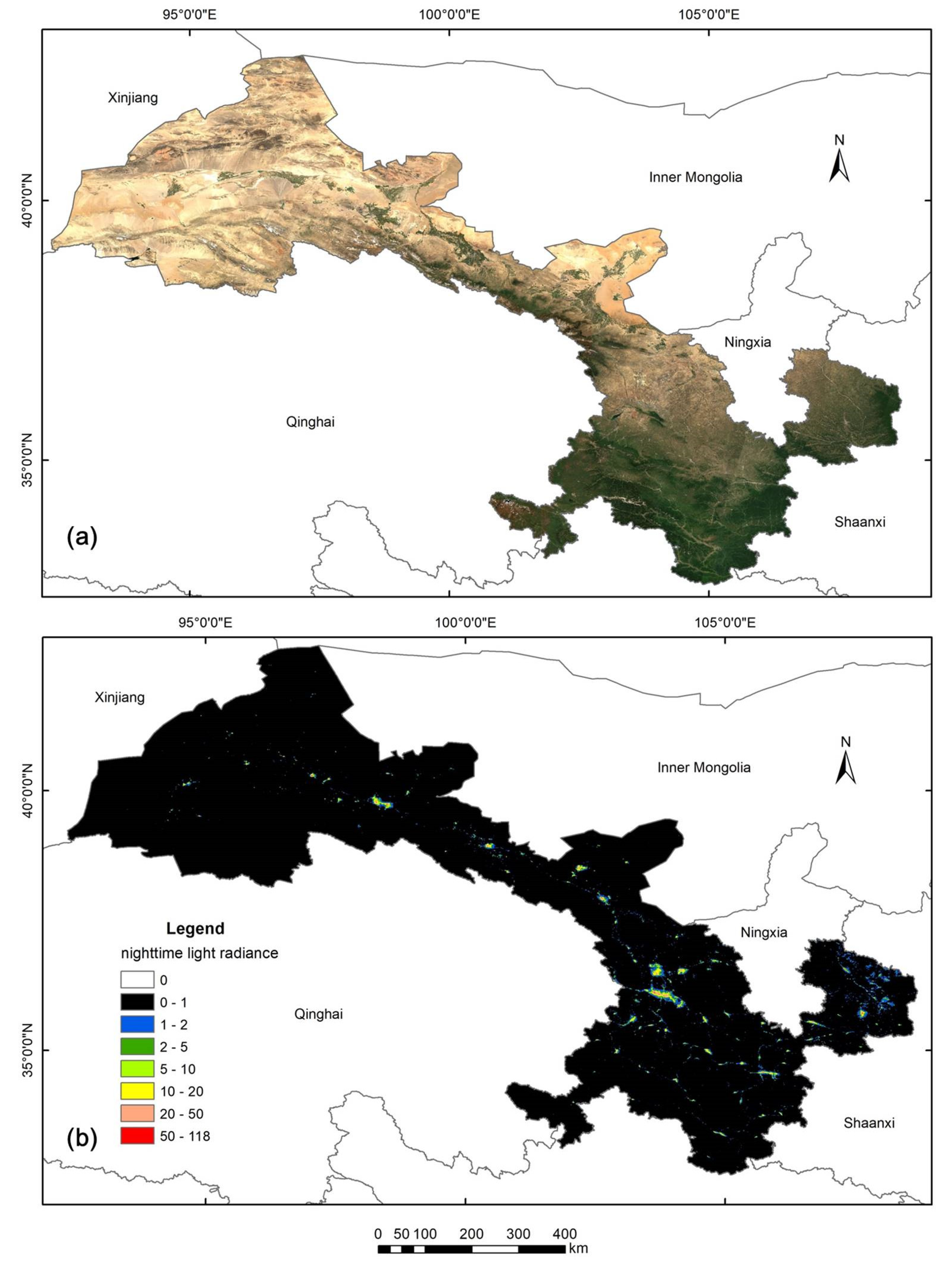
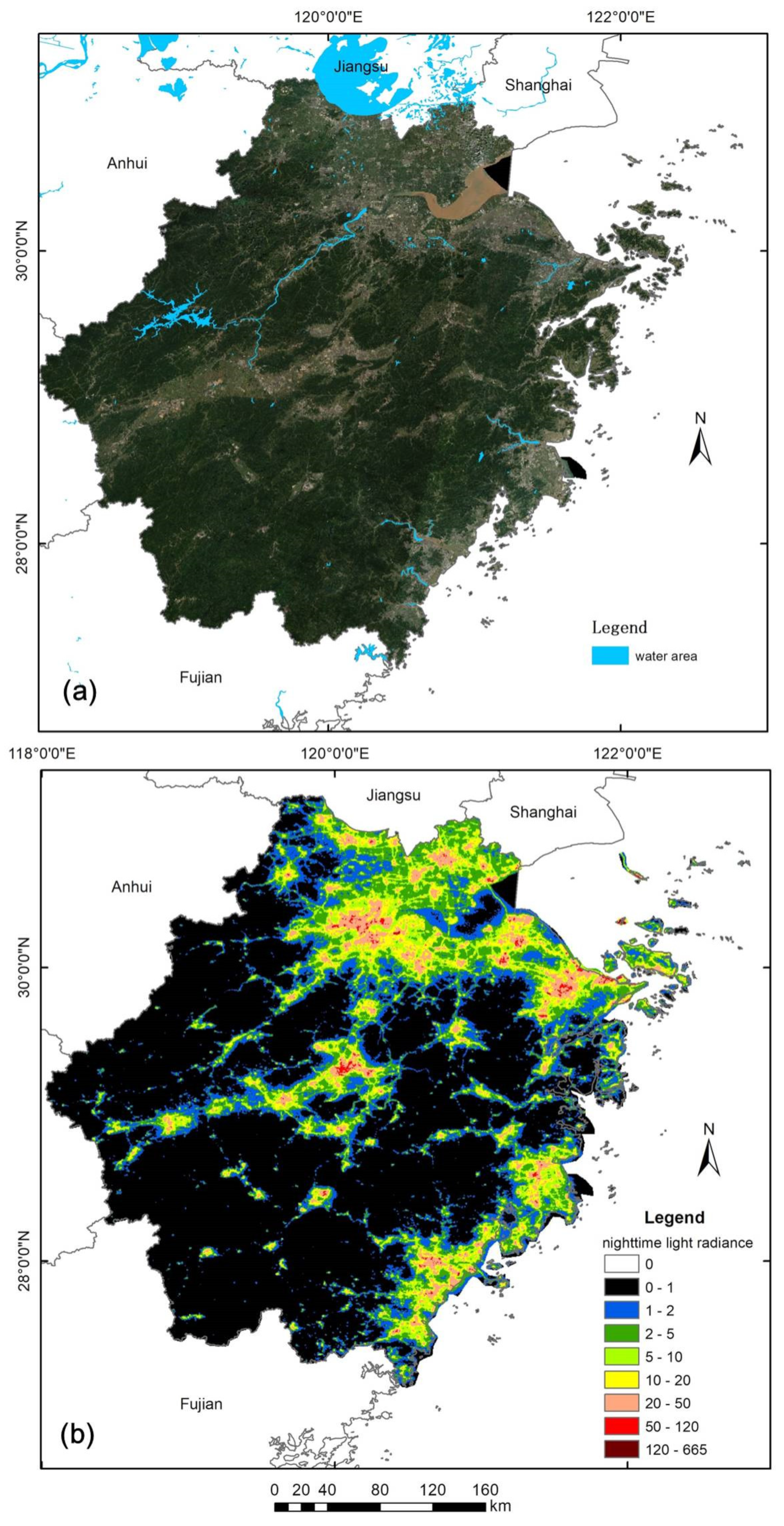
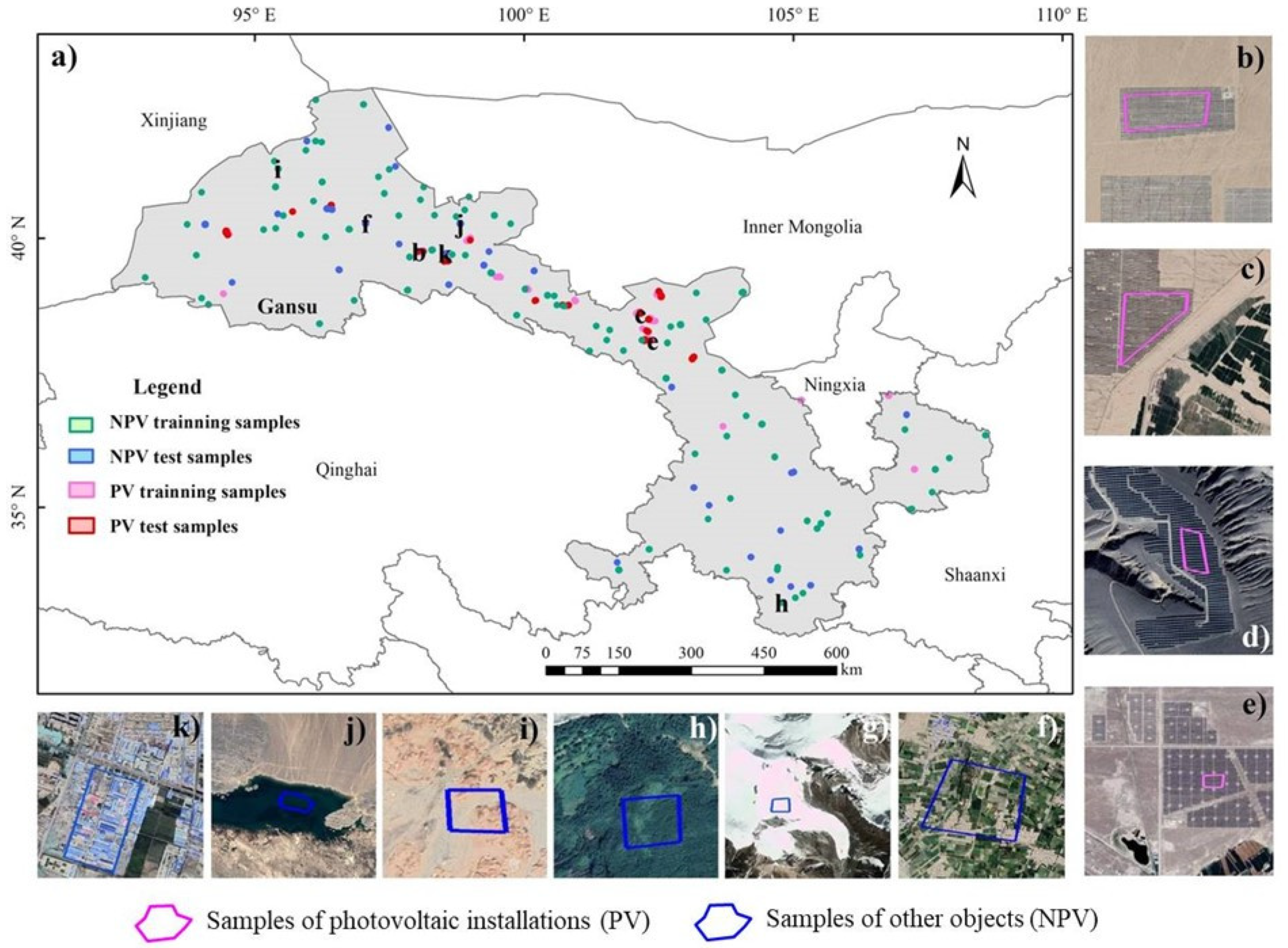
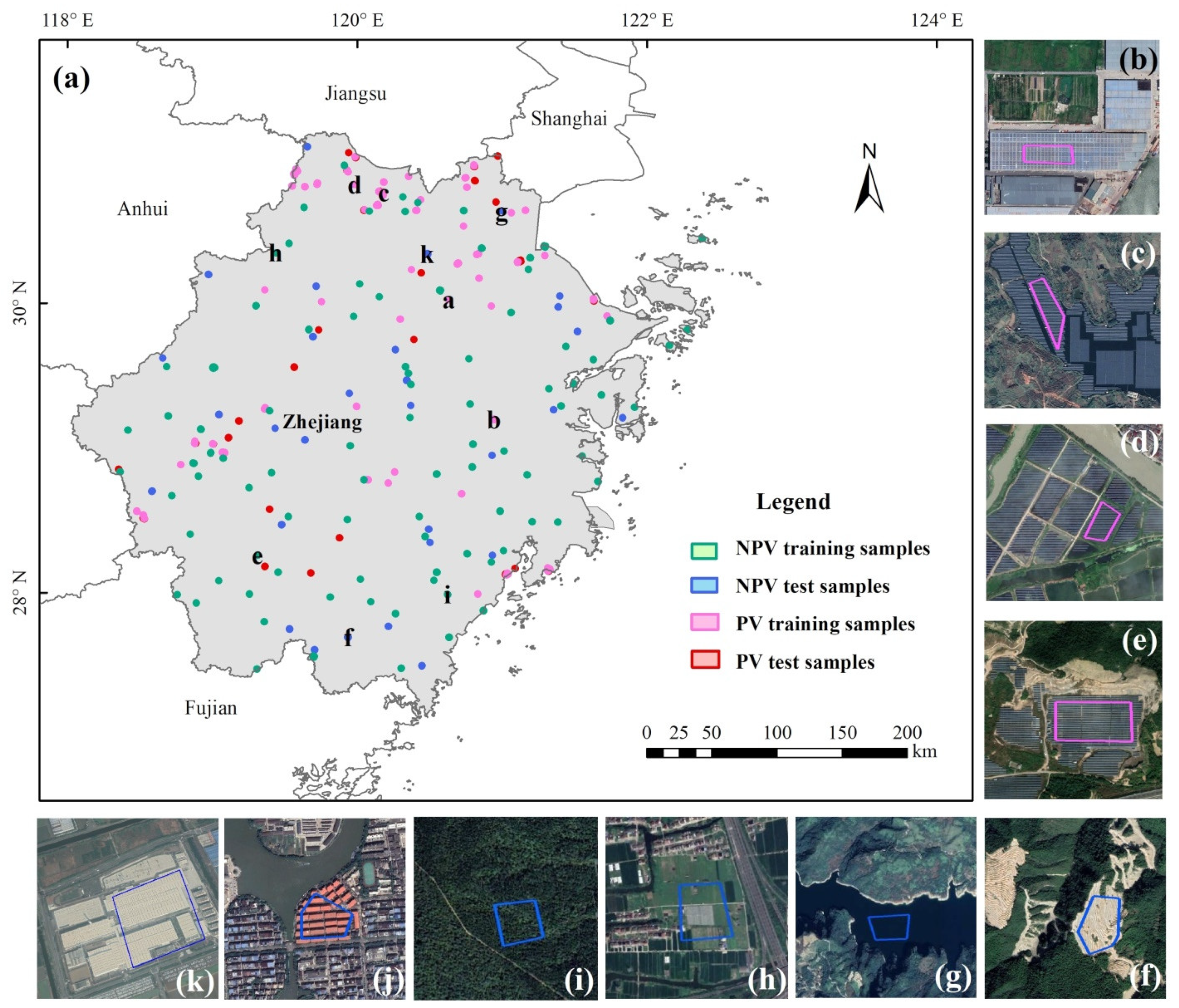
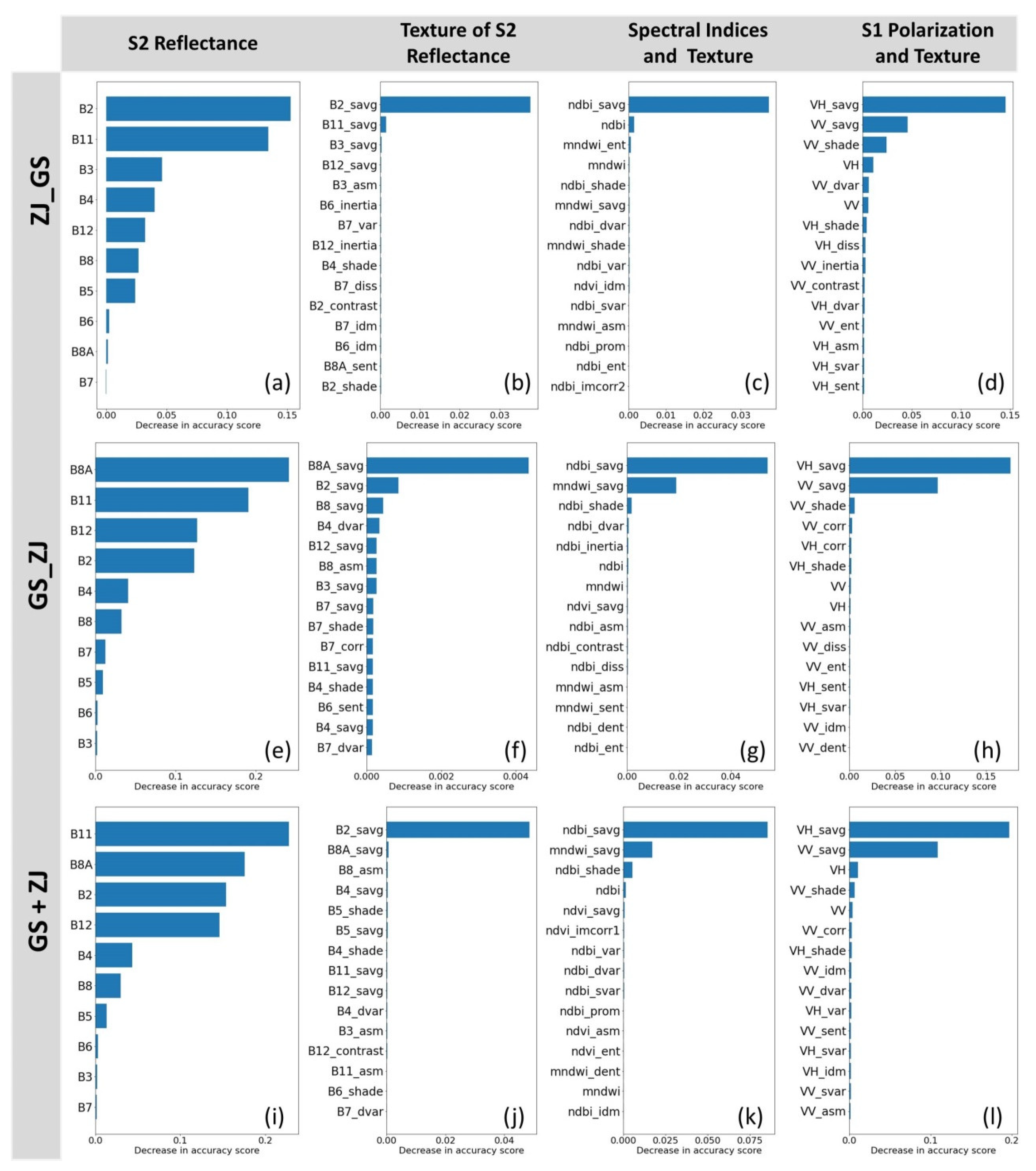
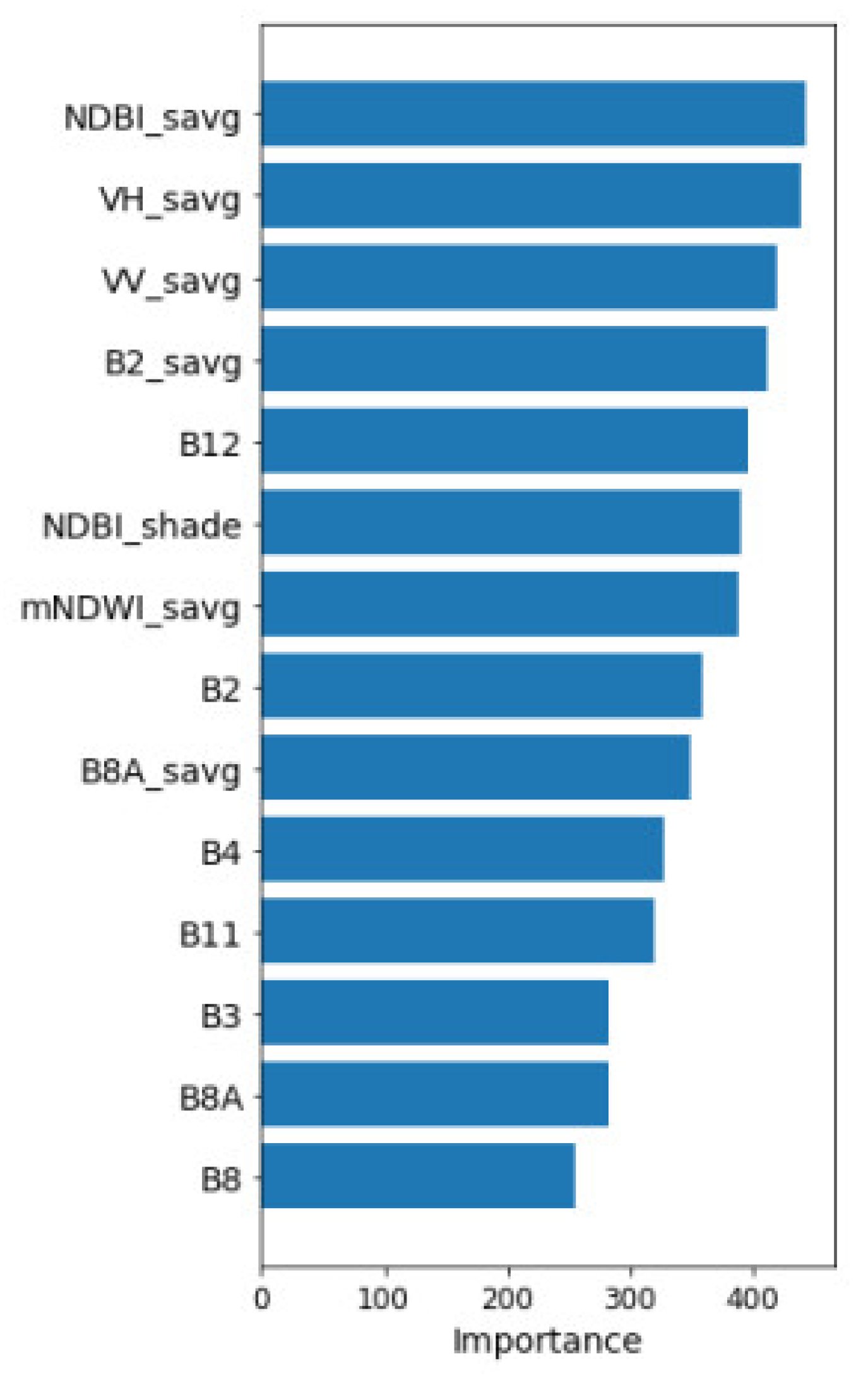

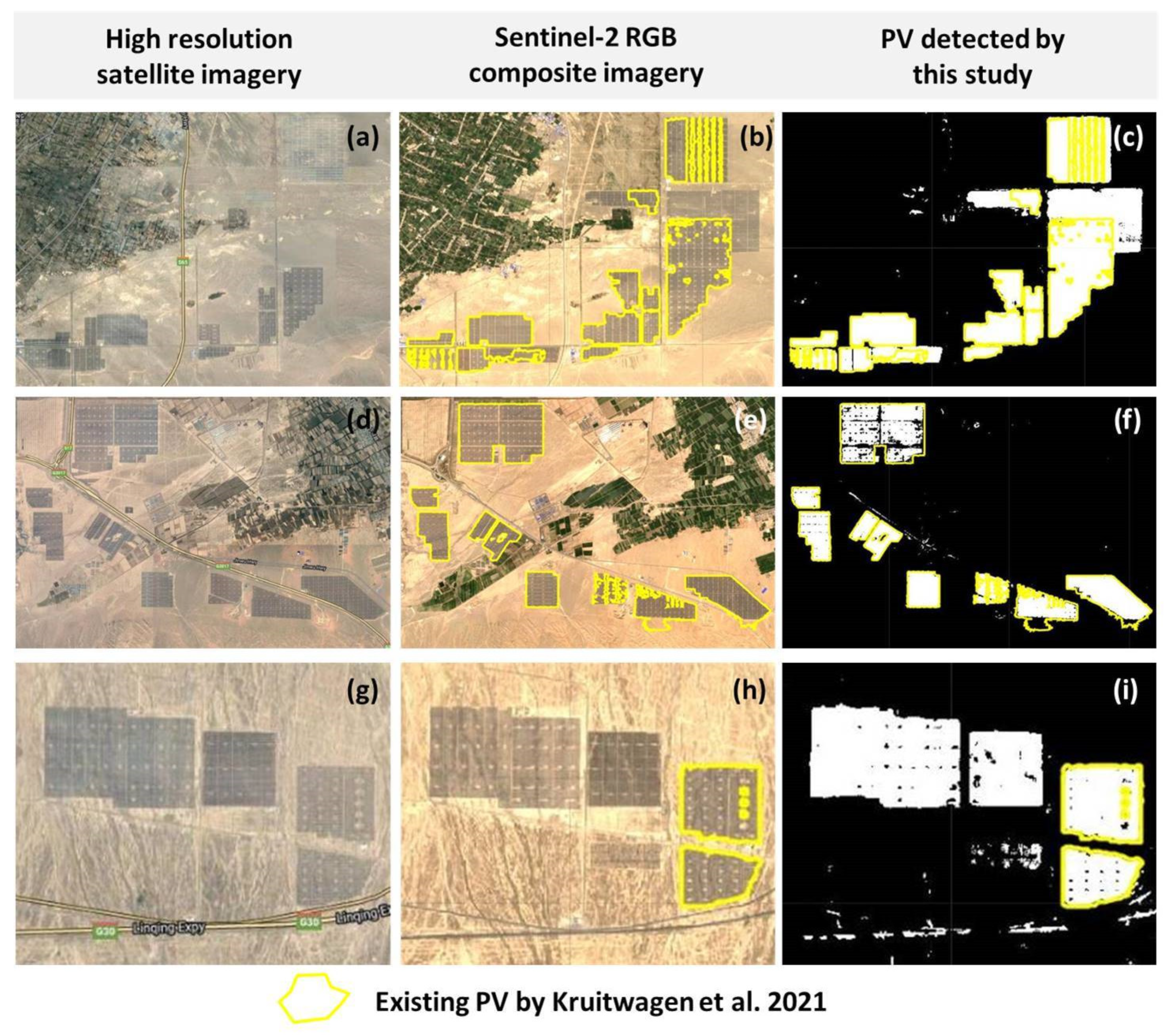
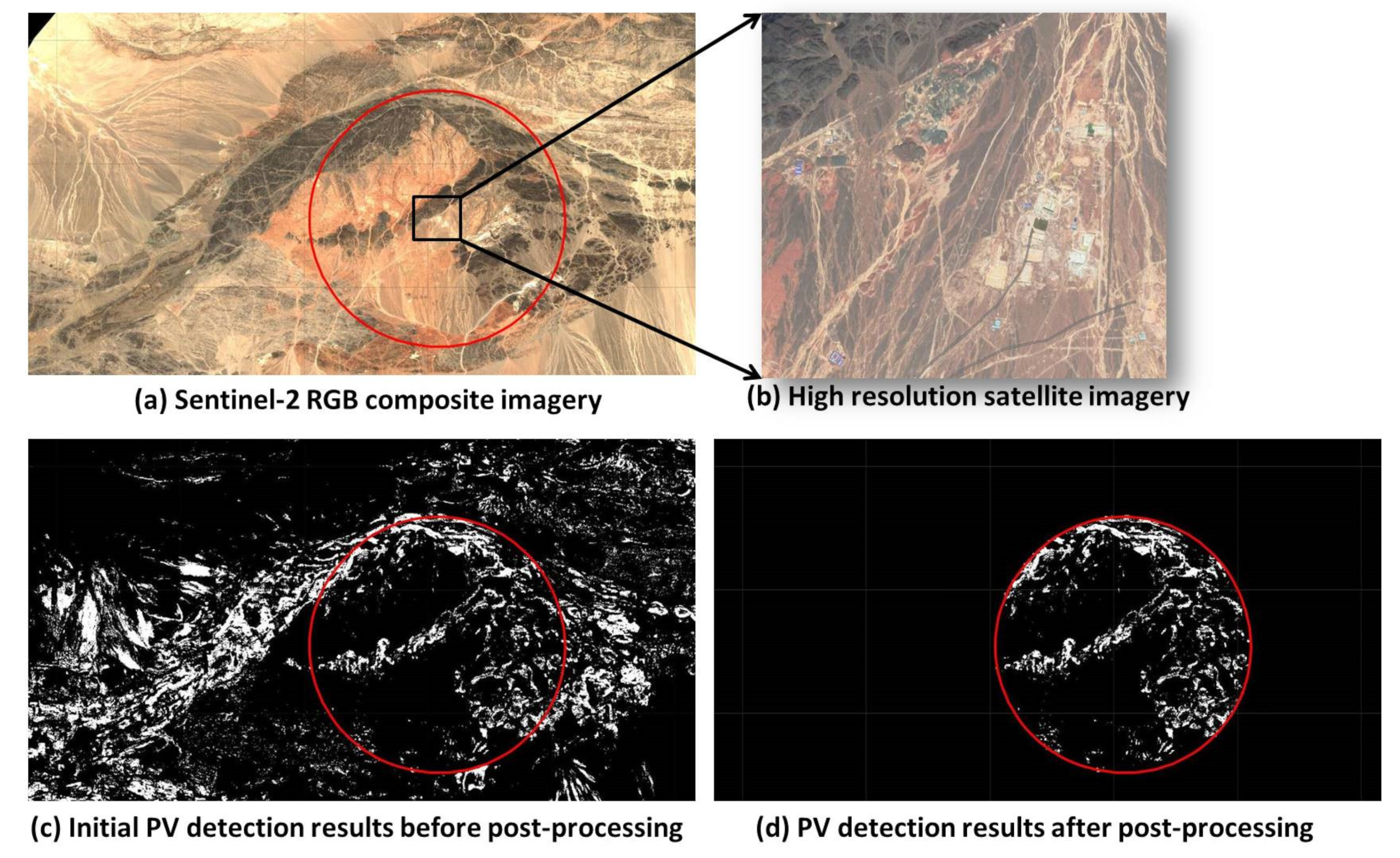

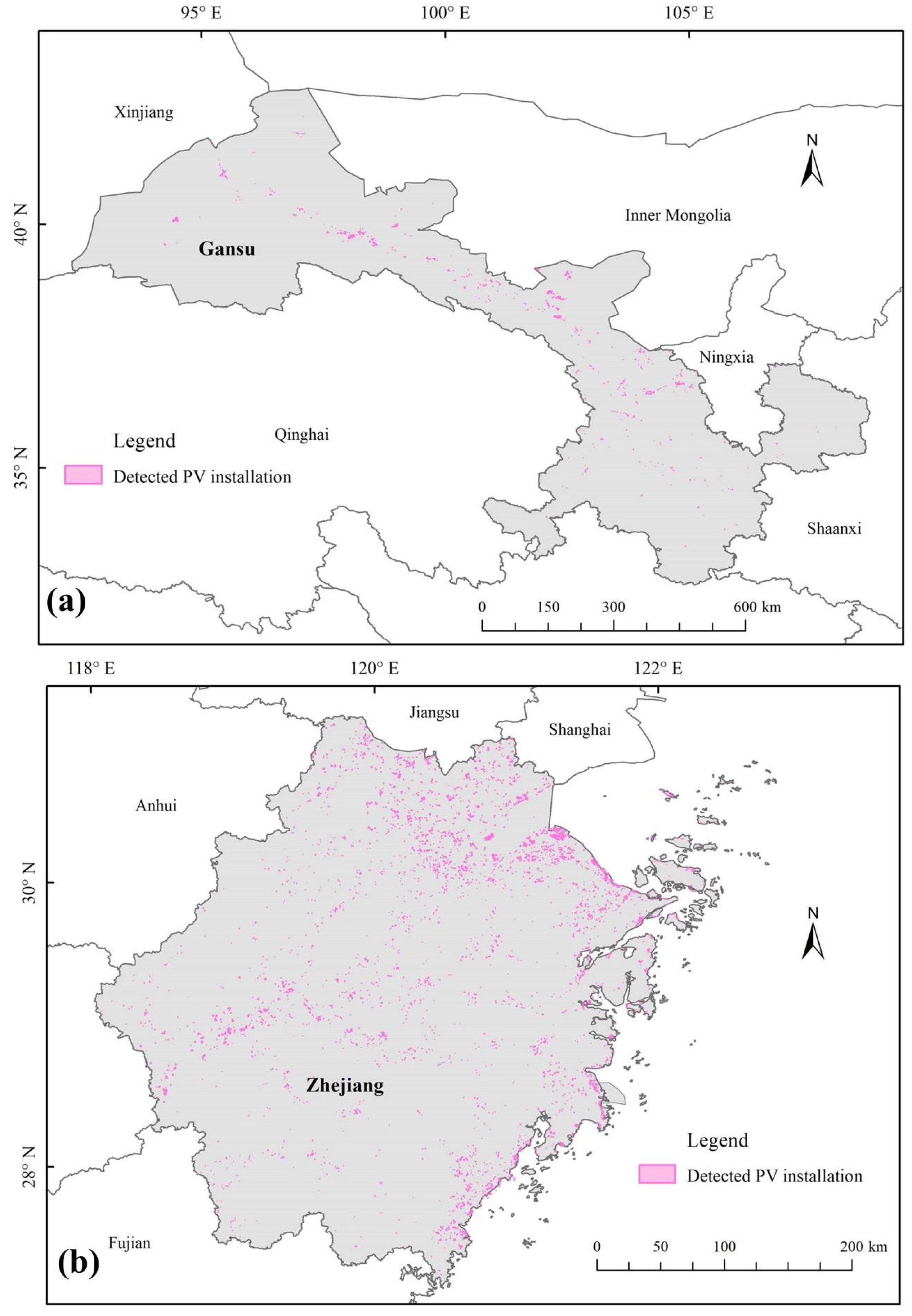
| Reference Database | Study Area | Number of PV Plants |
|---|---|---|
| GPPD | Gansu | 190 |
| Kruitwagen et al., 2021 [12] | Gansu | 253 |
| Xia et al., 2022 [15] | Gansu | 195 |
| GPPD | Zhejiang | 30 |
| Kruitwagen et al., 2021 [12] | Zhejiang | 173 |
| Texture Symbol | Description |
|---|---|
| _asm | angular second moment |
| _contrast | contrast |
| _corr | correlation |
| _var | variance |
| _idm | inverse difference moment |
| _savg | sum average |
| _svar | sum variance |
| _sent | sum entropy |
| _ent | entropy |
| _dvar | difference variance |
| _dent | difference entropy |
| _imcorr1 | information measure of Corr. 1 |
| _imcorr2 | information measure of Corr. 2 |
| _diss | dissimilarity |
| _inertia | inertia |
| _shade | cluster shade |
| _prom | cluster prominence |
| Feature Groups | Number | Specific Features |
|---|---|---|
| S2 reflectance | 10 | B2, B3, B4, B5, B6, B7, B8, B8A, B11, B12 |
| Texture of S2 reflectance | 170 | Texture of B2, B3, B4, B5, B6, B7, B8, B8A, B11, B12 |
| Spectral indices & Texture | 54 | NDBI, NDVI, mNDWI Texture of NDBI, NDVI, mNDWI |
| S1 polarization & Texture | 36 | VV, VH Texture of VV and VH |
| Scheme | Training Samples | Test Samples |
|---|---|---|
| GS_ZJ | Train_PV_GS + Train_NPV_GS | Test_PV_ZJ + Test_NPV_ZJ |
| ZJ_GS | Train_PV_ZJ + Train_NPV_ZJ | Test_PV_GS+ Test_NPV_GS |
| GS+ZJ | Train_PV_GS + Train_NPV_GS + Train_PV_ZJ + Train_NPV_ZJ | Test_PV_ZJ + Test_NPV_ZJ + Test_PV_GS + Test_NPV_GS |
| Groups | ZJ_GS | GS_ZJ | GS+ZJ |
|---|---|---|---|
| S2 reflectance | B2, B3, B4, B8, B8A, B11, B12 | B2, B3, B4, B8, B8A, B11, B12 | B2, B3, B4, B8, B8A, B11, B12 |
| Texture of S2 reflectance | B2_savg, B11_savg | B8A_savg, B2_savg | B2_savg, B8A_savg |
| S1 polarization & Texture | VH_savg, VV_savg | VH_savg, VV_savg | VH_savg, VV_savg |
| Spectral indices & Texture | NDBI_savg, NDBI | NDBI_savg, mNDWI_savg | NDBI_savg, mNDWI_savg, NDBI_shade |
| Total Number | 13 | 13 | 14 |
| Scheme | OA | Kappa | UA_PV | PA_PV | UA_NPV | PA_NPV |
|---|---|---|---|---|---|---|
| GS_ZJ | 68.84% | 0.44 | 100% | 58.70% | 46.53% | 100% |
| ZJ_GS | 97.24% | 0.94 | 96.08% | 98.99% | 98.74% | 95.12% |
| GS+ZJ | 98.90% | 0.98 | 99.71% | 98.39% | 97.79% | 99.60% |
| Reference Database | Study Area | Number of PV | TP | Detection Rate |
|---|---|---|---|---|
| GPPD | Gansu | 190 | 183 | 96.31% |
| Kruitwagen et al., 2021 [12] | Gansu | 253 | 239 | 94.47% |
| Xia et al., 2022 [15] | Gansu | 195 | 190 | 97.44% |
| GPPD | Zhejiang | 30 | 26 | 86.67% |
| Kruitwagen et al., 2021 [12] | Zhejiang | 173 | 164 | 94.80% |
Publisher’s Note: MDPI stays neutral with regard to jurisdictional claims in published maps and institutional affiliations. |
© 2022 by the authors. Licensee MDPI, Basel, Switzerland. This article is an open access article distributed under the terms and conditions of the Creative Commons Attribution (CC BY) license (https://creativecommons.org/licenses/by/4.0/).
Share and Cite
Wang, J.; Liu, J.; Li, L. Detecting Photovoltaic Installations in Diverse Landscapes Using Open Multi-Source Remote Sensing Data. Remote Sens. 2022, 14, 6296. https://doi.org/10.3390/rs14246296
Wang J, Liu J, Li L. Detecting Photovoltaic Installations in Diverse Landscapes Using Open Multi-Source Remote Sensing Data. Remote Sensing. 2022; 14(24):6296. https://doi.org/10.3390/rs14246296
Chicago/Turabian StyleWang, Jinyue, Jing Liu, and Longhui Li. 2022. "Detecting Photovoltaic Installations in Diverse Landscapes Using Open Multi-Source Remote Sensing Data" Remote Sensing 14, no. 24: 6296. https://doi.org/10.3390/rs14246296




